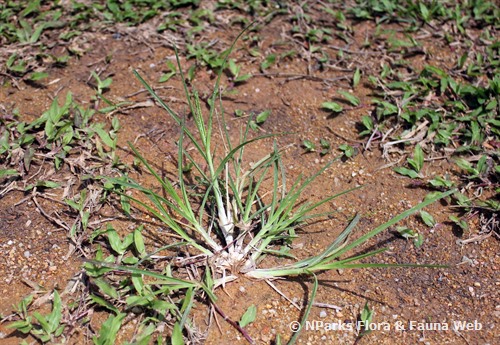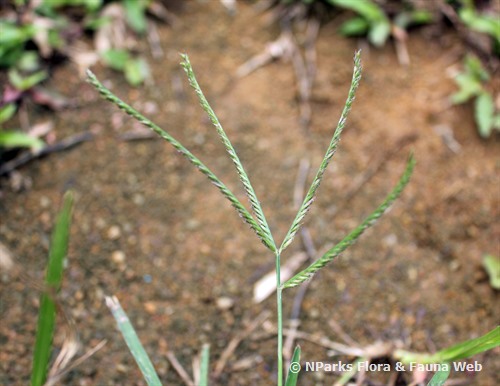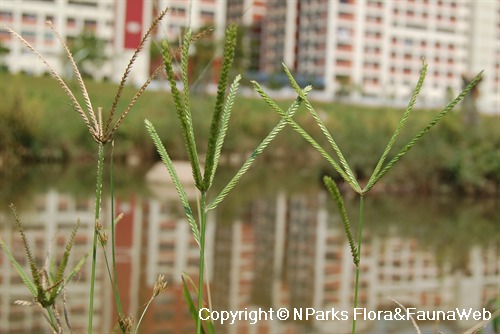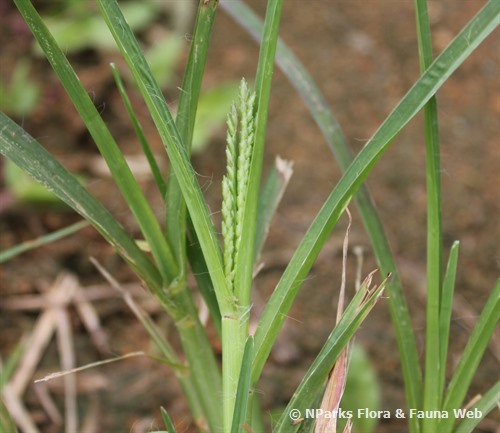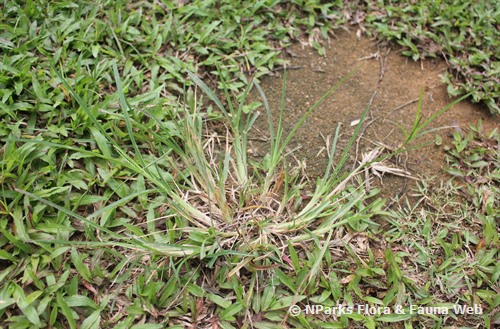
Back
Eleusine indica (L.) Gaertn.
| Family Name: | Poaceae (Gramineae) |
| Common Name: | Indian Goosegrass, Silver Crabgrass, Yardgrass, Wiregrass, Crowfoot Grass, 牛筋草 |
Name
Classifications and Characteristics
| Plant Division | Angiosperms (Flowering Seed Plants) (Monocotyledon) |
|---|---|
| Plant Growth Form | Shrub, Grass or Grass-like Plant (Short Grass (Poaceae)) |
| Lifespan (in Singapore) | Perennial |
| Mode of Nutrition | Autotrophic |
| Plant Shape | Grassy |
| Maximum Height | 0.3 m to 0.6 m |
Description and Ethnobotany
| Growth Form | Annual herb up to 0.3-0.6 m tall. |
|---|---|
| Roots | It has an extensive root system. |
| Foliage | Narrow, linear leaves (3-8 mm wide) occur in alternate leaf arrangement (one leaf per point along the stem). The leaf blade may lie flat or be folded. The base of the leaf which wraps around the stem (leaf sheath) is smooth. |
| Stems | Flowering stems (known as culms) are held erect or prostrate (lying parallel to the ground). They are smooth and slightly flattened. |
| Flowers | Digitate spike inflorescence is composed of 2-6 spikes (4-15 cm long) which are united at the base, forming finger-like structures. One spike is often positioned slightly lower than the others on the flowering stem. Each spike is composed of numerous spikelets, and each spikelet is composed of 3-15 florets (reduced flowers without petals or sepals). |
| Fruit | Black, ellipsoid seeds (1.5 - 2 mm long) have a wrinkled surface and are enclosed by loose, membranous tissue. |
| Habitat | Occurs along roadsides, disturbed areas and wastelands. |
| Similar | This species resembles Chloris spp. and Dactyloctenium spp., but the spikes lack bristles (awnless). |
| Cultivation | This species is not typically grown for ornamental or ethnobotanical uses. It is generally considered a weed. The large root system is difficult to remove manually. |
| Ethnobotanical Uses | Edible Plant Parts : Edible Seeds Medicinal: In Malaysia, the juice from the crushed leaves is drunk to promote discharge of the afterbirth. In Indonesia, the plant is used to expel worms from the intestine. In Indochina, it is used to induce sweating and to control fever. In the Philippines, it is used to prevent dysentery. Others: In India, people consume the seeds when other foods are scarce due to drought. |
Plant Care and Propagation
| Light Preference | Full Sun, Semi-Shade |
|---|---|
| Water Preference | Moderate Water |
| Maintenance Requirements | Low |
| Propagation Method | Seed |
Floral (Angiosperm)
| Flower & Plant Sexuality | Bisexual Flowers |
| Flower Grouping | Cluster / Inflorescence |
|---|---|
| Flower Location | Terminal |
| Flower Symmetry | Asymmetrical |
| Inflorescence Type | Spike |
Fruit, Seed and Spore
| Fruit Classification | Simple Fruit |
|---|---|
| Fruit Type | Indehiscent Dry Fruit , Caryopsis / Grain |
Image Repository
Others
| Master ID | 30782 |
|---|---|
| Species ID | 5136 |
| Flora Disclaimer | The information in this website has been compiled from reliable sources, such as reference works on medicinal plants. It is not a substitute for medical advice or treatment and NParks does not purport to provide any medical advice. Readers should always consult his/her physician before using or consuming a plant for medicinal purposes. |

